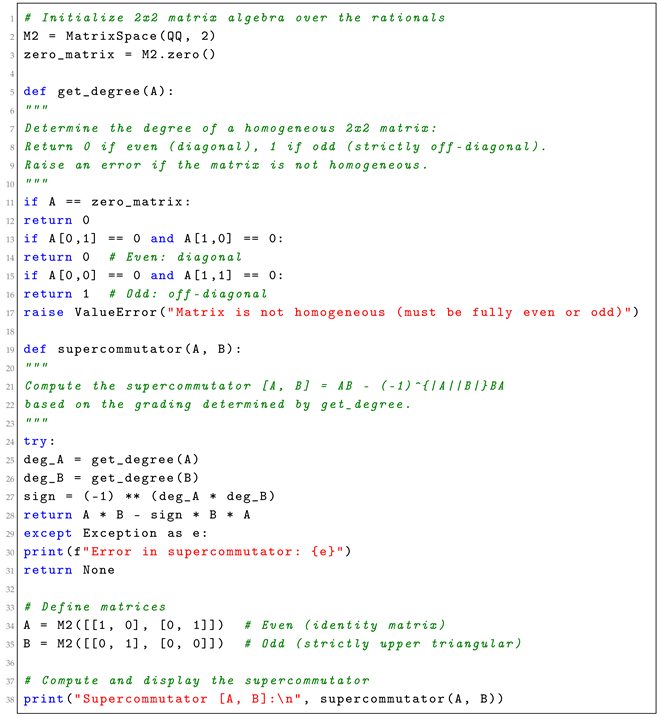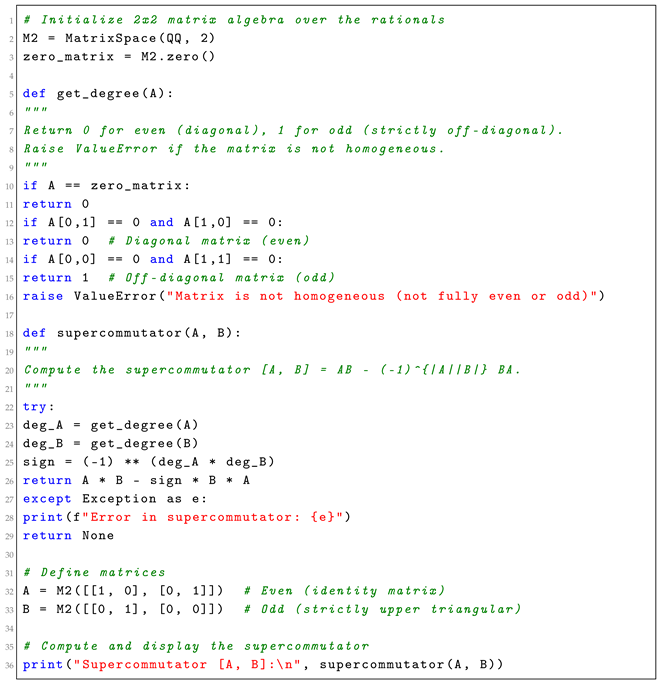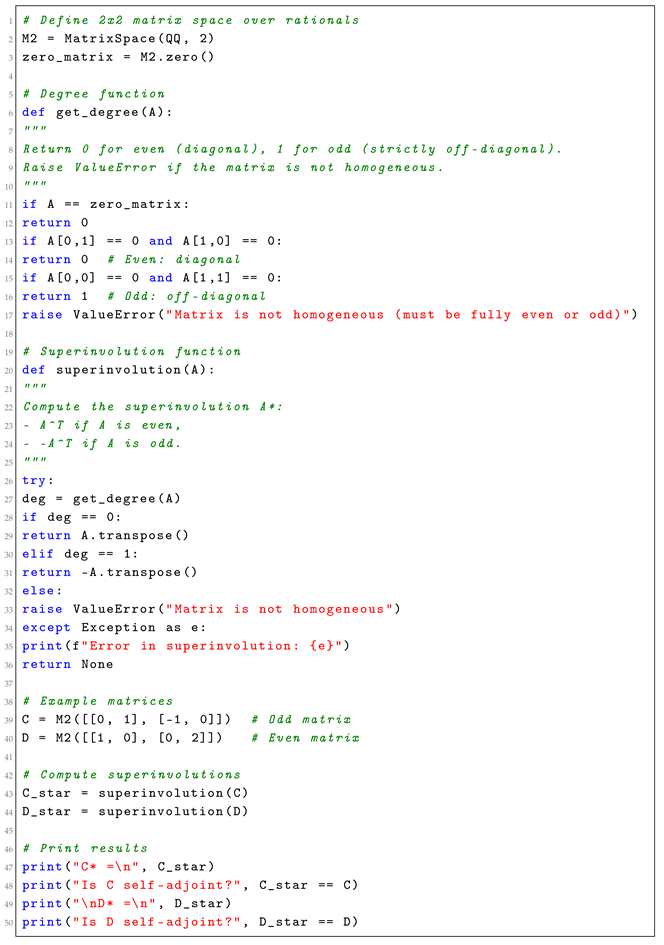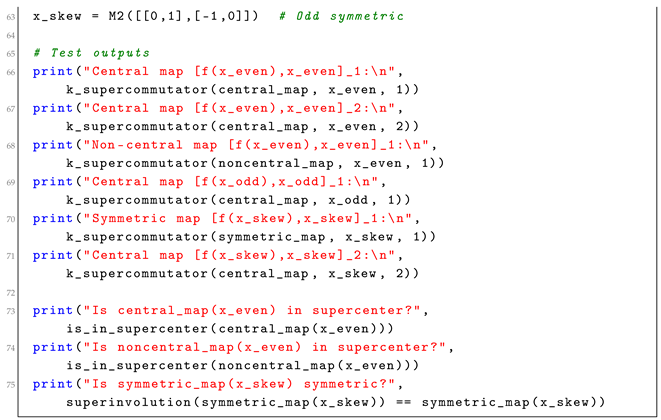1. Introduction
Superalgebras arise as a natural extension of classical algebraic structures by incorporating a
-grading that distinguishes between even and odd elements. Historically, the concept of superalgebras emerged in the 1970s, motivated by developments in theoretical physics, particularly in supersymmetry and quantum field theory. Victor Kac’s seminal work rigorously formalized Lie superalgebras, laying a foundation for the algebraic treatment of symmetry principles that mix commuting and anticommuting variables [
1].
A
superalgebra over a commutative ring
with
is an associative algebra equipped with a
-grading such that
for
. Elements in
are called
even, and those in
are
odd. Homogeneous elements
have degree
. The grading automorphism
defined by
satisfies
, identifying
Superalgebras have profound applications not only in physics but also in pure mathematics, including representation theory, noncommutative geometry, and homological algebra [
2,
3,
4,
5,
6,
7,
8,
9,
10].
Functional identities, first developed by Brešar for rings were adapted by Wang to the graded setting, leading to the notion of
d-superfree subsets, which guarantee the existence of standard solutions to certain functional equations [
11].
Building upon this foundation, our paper introduces new theorems concerning superinvolutions and
k-supercommuting maps in prime superalgebras. We emphasize computational verification using SageMath [
12] in the specific case of
, validating theoretical results such as the behavior of supercommutators, superinvolutions, and
k-supercommuting maps [
13,
14]. This approach bridges the gap between abstract theory and explicit finite-dimensional examples, providing novel insights into the structure and applications of superalgebras.
The paper concludes by discussing implications for Lie superalgebras and proposing open problems for further exploration.
2. Preliminaries
Definition 1. superalgebra over a field with is a -graded associative algebra satisfyingfor . Elements in are called homogeneous with degree for [1]. Example 1. The algebra of matrices over is a superalgebra withIt’s supercenter consists of scalar diagonal matrices Example 2. The Clifford algebra over is a superalgebra with basis satisfyingThe even part is spanned by , and the odd part by . Definition 2. For homogeneous elements , the supercommutator is defined byExtending bilinearly to all and with , we have Definition 3. A superinvolution ‘∗
’ on is a graded -linear map satisfyingThe set of symmetric elements isand the set of skew-symmetric elements is Definition 4. Let be a graded -submodule of . A map is k-supercommuting if for all ,where the iterated supercommutators are defined recursively by 3. Functional Identities and -Superfree Subsets
Functional identities in superalgebras extend classical ring theory to the graded setting, capturing
-graded behavior. Wang introduced the notion of
d-superfree subsets to guarantee uniqueness of standard solutions to functional identities [
15].
Definition 5 (
d-Superfree Triples).
Let be a unital superalgebra with center and grading automorphism σ. Fix an element such thatA triple is called d-superfree if for any subsets withthe functional identityimplies the existence of such that the standard solutionholds. Moreover, ifand the sum in (
1)
lies in , the same conclusion applies [15]. Example 3. In , taking and considering the functional identity for , one obtains that lies in the supercenter (cf. computations in Section 6). Example 4. In , consider the functional identityfor a homogeneous map E. This forces for all , illustrating a trivial standard solution. Theorem 1 (Uniqueness of Standard Solutions).
For a d-superfree triple , the functional identitieswithand similarly when the sum lies in foradmit unique standard solutions given by (
2)
(Theorem 3.4, [15]). Proof. See (Theorem 3.4, [
15]). □
4. Results in Prime Superalgebras
Theorem 2. Let be a prime superalgebra with grading automorphism σ. If σ is outer, thenwhere Proof. See (Theorem 4.1, [
15]). □
Theorem 3. Let be a semiprime superalgebra with maximal left ring of quotients . For and , if is left independent over relative to , then there exist such that Proof. See (Theorem 4.2, [
15]). □
Theorem 4. Let be a prime superalgebra with superinvolution ∗
. Ifthen and are d-superfree [15]. Proof. See (Theorem 5.10, [
15]). □
5. -Supercommuting Maps
Theorem 5. Let be a unital superalgebra with supercenter . Let be a graded -submodule of . Suppose is -linear and satisfiesand is -superfree. Then Proof. See (Theorem 6.1, [
15]). □
Corollary 1. Let be a prime superalgebra with maximal left ring of quotients . If is k-supercommuting andthenthe center of the even part [15]. Corollary 2. Let be a prime superalgebra with superinvolution ∗
. For or , if is k-supercommuting andthen Theorem 6. Let be a prime superalgebra with superinvolution ∗
. If is k-supercommuting andthen Proof. Let
. By hypothesis
f is
k-supercommuting on
, so
The degree condition
ensures that
satisfies the superfreeness hypothesis required to apply Corollary 2. Thus Corollary 2 gives
where
denotes the even part of the center of
.
In a prime superalgebra equipped with a superinvolution the even central elements are invariant under the involution. Hence every satisfies . Since for all , we obtain for every , as required. □
Theorem 7. Let be a prime superalgebra with superinvolution ∗
. If is k-supercommuting andthen Proof. Let
. Since
f is
k-supercommuting on
, we have
The degree bound
permits application of Corollary 2 to the skew subspace
; hence
Therefore, for each
the element
lies in
, and so
.
But every satisfies . If were also skew (i.e., ), then , contradicting unless . Equivalently, since in the prime superalgebra setting, the inclusion forces for every . This completes the proof. □
6. Computational Examples
We verify results in , with grading:
: diagonal matrices, e.g., .
: off-diagonal matrices, e.g., .
The supercenter consists of scalar matrices .
6.1. Supercommutator Implementation
An explicit SageMath implementation of supercommutator is shown in Listing 1.
| Listing 1. SageMath implementation of superalgebra operations. |
![Symmetry 17 01527 i001 Symmetry 17 01527 i001]() |
6.2. Supercommutator Examples
Example 5. For (even) and (odd): SageMath implementation for calculating supercommutator is presented in Listing 2.
| Listing 2. Verification of supercommutator. |
![Symmetry 17 01527 i002 Symmetry 17 01527 i002]() |
Output:
Supercommutator [A,B]:
[0 0]
[0 0]
Example 6. For (even) and (odd): SageMath implementation for calculating an additional supercommutator is presented in Listing 3.
| Listing 3. Additional supercommutator verification. |
![Symmetry 17 01527 i003 Symmetry 17 01527 i003]() |
Output:
Supercommutator [A,B]:
[0 0]
[1 0]
Example 7. For (odd) and (odd): SageMath code for the calculation of a odd supercommutator appears in Listing 4.
| Listing 4. Odd supercommutator verification. |
![Symmetry 17 01527 i004 Symmetry 17 01527 i004]() |
Output:
Supercommutator [A,B]:
[1 0]
[0 1]
6.3. Superinvolution Implementation
SageMath implementation for calculating superinvolution is presented in Listing 5.
| Listing 5. Superinvolution implementation. |
![Symmetry 17 01527 i005 Symmetry 17 01527 i005]() |
6.4. Superinvolution Examples
Example 8. Let , which is an odd matrix. Then the superinvolution is computed as:Thus, C is self-adjoint under the superinvolution. SageMath code for the calculation of a superinvolution appears in Listing 6.
| Listing 6. Verification of superinvolution. |
![Symmetry 17 01527 i006 Symmetry 17 01527 i006]() |
C*:
[ 0 1]
[-1 0]
Is C self-adjoint? True
Example 9. For , which is an even matrix:Thus, D is self-adjoint under the superinvolution. SageMath implementation for calculating additional superinvolution is presented in Listing 7.
| Listing 7. Additional superinvolution verification. |
![Symmetry 17 01527 i007 Symmetry 17 01527 i007]() |
D*:
[1 0]
[0 2]
Is D self-adjoint? True
Example 10. For , which is an odd matrix:Thus, E is not self-adjoint under the superinvolution. SageMath implementation for calculating non-selfadjoint superinvolution is presented in Listing 8.
| Listing 8. Non-selfadjoint superinvolution. |
![Symmetry 17 01527 i008 Symmetry 17 01527 i008]() |
E*:
[ 0 -1]
[-1 0]
Is E self-adjoint? False
6.5. k-Supercommuting Maps
SageMath implementation for calculating k-supercommuting map is presented in Listing 9.
| Listing 9. k-supercommuting map verification. |
![Symmetry 17 01527 i009a Symmetry 17 01527 i009a]() |
![Symmetry 17 01527 i009b Symmetry 17 01527 i009b]() |
Central map [f(x_even),x_even]_1:
[0 0]
[0 0]
Central map [f(x_even),x_even]_2:
[0 0]
[0 0]
Non-central map [f(x_even),x_even]_1:
[0 0]
[0 0]
Central map [f(x_odd),x_odd]_1:
[0 0]
[0 0]
Symmetric map [f(x_skew),x_skew]_1:
[0 0]
[0 0]
Central map [f(x_skew),x_skew]_2:
[0 0]
[0 0]
Is central_map(x_even) in supercenter? True
Is noncentral_map(x_even) in supercenter? False
Is symmetric_map(x_skew) symmetric? True
6.6. Visualization of Supercommutator Norms
To quantify the behavior of supercommutators, we compute the Frobenius norm for pairs of matrices. SageMath implementation for calculating Frobenius norm of supercommutators is presented in Listing 10.
| Listing 10. Frobenius norm of supercommutators. |
![Symmetry 17 01527 i010 Symmetry 17 01527 i010]() |
Output:
Frobenius norms = \([0, 1, \sqrt{2}]\).
7. Applications to Lie Superalgebras
Functional identities provide deep insights into the structure of Lie superalgebras, where the supercommutator serves as the Lie bracket. The set of skew elements relative to a superinvolution forms a Lie superalgebra. Theorems 6 and 7 indicate that k-supercommuting maps on and produce central elements, which are crucial for constructing central extensions.
Proposition 1. Let be a prime superalgebra equipped with a superinvolution ‘∗
’. Then , the set of skew elements, forms a Lie superalgebra under the supercommutator bracket . Moreover, Proof. For homogeneous
, we have
and
. Consider
Hence,
. The graded Jacobi identity follows from associativity and the properties of the supercommutator. □
Example 11. In , the matrixsatisfies and , consistent with the Lie superalgebra structure. Example 12. ConsiderSince (where ‘∗
’ is the superinvolution, here the transpose combined with a sign), the bracket lies in , illustrating the grading in the Lie superalgebra. 8. Open Problems and Future Directions
This study prompts several open questions:
Can the degree bounds in Theorem 4 be improved specifically for matrix superalgebras?
Under what conditions do k-supercommuting maps on non-prime superalgebras map into the supercenter?
How can functional identities be extended to -graded algebras beyond the -graded case?
Can computational and symbolic methods effectively predict the structure of d-superfree subsets in higher-dimensional superalgebras?
These questions, together with the computational evidence presented, highlight promising directions for further research into superalgebra structures via symbolic computation and functional identities.
9. Conclusions
This study advances the theory of functional identities in superalgebras by extending Wang’s framework. In particular, Theorems 6 and 7 establish that k-supercommuting maps on symmetric elements of prime superalgebras with superinvolution map into the even center, while those on skew elements vanish, under suitable degree conditions. These results highlight the deep interaction between -grading and superinvolutions.
Computational experiments in using SageMath corroborate the theoretical framework, verifying the behavior of supercommutators, superinvolutions, and k-supercommuting maps, and thereby bridging abstract results with explicit finite-dimensional examples. The implications for Lie superalgebras are significant: skew elements form a Lie superalgebra under the supercommutator, offering new insights into symmetry in algebraic structures.
Finally, the open problems posed in
Section 8 including sharpening degree bounds and extending the theory to
-graded algebras point toward rich directions for further research. By combining rigorous theory with computational validation, this work deepens the understanding of superalgebras and reinforces their role in both mathematics and theoretical physics, in line with the interdisciplinary scope of symmetry-driven research.
Author Contributions
Conceptualization, A.Y.H. and M.S.A.; Methodology, A.Y.H. and M.S.A.; Software, A.Y.H. and M.S.A.; Validation, A.Y.H. and M.S.A.; Formal Analysis, A.Y.H. and M.S.A.; Investigation, A.Y.H. and M.S.A.; Resources, A.Y.H. and M.S.A.; Data Curation, A.Y.H. and M.S.A.; Writing—Original Draft Preparation, A.Y.H. and M.S.A.; Writing—Review and Editing, A.Y.H. and M.S.A.; Visualization, A.Y.H. and M.S.A.; Supervision, A.Y.H.; Project Administration, A.Y.H.; Funding Acquisition, A.Y.H. All authors have read and agreed to the published version of the manuscript.
Funding
This research was funded by The Deanship of Scientific Research at King Khalid University, Abha, Saudi Arabia, grant number RGP.2/340/46.
Data Availability Statement
Data are contained within the article.
Conflicts of Interest
The authors declare no conflicts of interest.
References
- Kac, V.G. Lie superalgebras. Adv. Math. 1977, 26, 8–96. [Google Scholar] [CrossRef]
- Beidar, K.I.; Chebotar, M.A. On functional identities and d-free subsets of rings, I. Commun. Algebra 2000, 28, 3925–3951. [Google Scholar] [CrossRef]
- Brešar, M.; Chebotar, M.A.; Martindale, W.S., III. Functional Identities; Birkhäuser: Basel, Switzerland, 2007. [Google Scholar]
- Elduque, A.; Villa, O. The existence of superinvolution. J. Algebra 2008, 319, 4338–4359. [Google Scholar] [CrossRef][Green Version]
- Gómez-Ambrosi, C.; Shestakov, I.P. On the Lie structure of skew elements of a simple superalgebra with superinvolution. J. Algebra 1998, 208, 43–71. [Google Scholar] [CrossRef][Green Version]
- Gómez-Ambrosi, C.; Laliena, J.; Shestakov, I.P. On the Lie structure of skew elements of a prime superalgebra with superinvolution. Commun. Algebra 2000, 28, 3277–3291. [Google Scholar] [CrossRef]
- Kharchenko, V.K. Generalized identities with automorphisms. Algebra Log. 1975, 14, 132–148. [Google Scholar] [CrossRef]
- Montaner, F. On the Lie structure of associative superalgebras. Commun. Algebra 1998, 26, 2337–2349. [Google Scholar] [CrossRef]
- Montgomery, S. Constructing simple Lie superalgebras from associative graded algebras. J. Algebra 1997, 195, 558–579. [Google Scholar] [CrossRef]
- Racine, M.L. Primitive superalgebras with superinvolution. J. Algebra 1998, 206, 588–614. [Google Scholar] [CrossRef]
- Brešar, M. Functional identities of degree two. J. Algebra 1995, 172, 690–720. [Google Scholar] [CrossRef]
- The SageMath Developers. SageMath, the Sage Mathematics Software System (Version 10.3). Available online: https://www.sagemath.org (accessed on 21 May 2025).
- Wang, Y. Skew-supercommuting maps in superalgebras. Bull. Aust. Math. Soc. 2008, 78, 397–409. [Google Scholar] [CrossRef]
- Wang, Y. Functional identities and Lie superhomomorphisms on prime superalgebras. Commun. Algebra 2009, 37, 4193–4226. [Google Scholar] [CrossRef]
- Wang, Y. Functional identities in superalgebras. J. Algebra 2013, 382, 144–176. [Google Scholar] [CrossRef]
| Disclaimer/Publisher’s Note: The statements, opinions and data contained in all publications are solely those of the individual author(s) and contributor(s) and not of MDPI and/or the editor(s). MDPI and/or the editor(s) disclaim responsibility for any injury to people or property resulting from any ideas, methods, instructions or products referred to in the content. |
© 2025 by the authors. Licensee MDPI, Basel, Switzerland. This article is an open access article distributed under the terms and conditions of the Creative Commons Attribution (CC BY) license (https://creativecommons.org/licenses/by/4.0/).
















